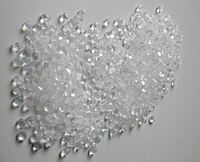
Photo from wikipedia
Abstract Temperature Rising Elution Fractionation (TREF) is effective for separating polyolefin resins according to crystallizability. A relatively low isothermal crystallization temperature is necessary to fractionate poly(1-butene) (PB-1) resin because of… Click to show full abstract
Abstract Temperature Rising Elution Fractionation (TREF) is effective for separating polyolefin resins according to crystallizability. A relatively low isothermal crystallization temperature is necessary to fractionate poly(1-butene) (PB-1) resin because of its slow crystallization kinetics. This study aims to investigate the influence of isothermal crystallization temperature of TREF on the fractionation and chain microstructure of eluted fractions for one poly(1-butene-co-ethylene) with 5.8 mol% ethylene. The resin is fractionated using P-TREF under four different isothermal crystallization temperatures, i.e. 0 °C, −5 °C, −10 °C, and −30 °C, and then the fractions are characterized by high-temperature gel permeation chromatography (HT-GPC), 13C nuclear magnetic resonance spectroscopy (13C NMR), and differential scanning calorimetry (DSC) to acquire their chain microstructure information. The isothermal crystallization temperature significantly affects the nucleation and growth of the crystals, which consequently results in differences in the relative content of eluted fractions. With the decrease of isothermal crystallization temperature from 0 °C to −30 °C, the copolymer is fractionated more effectively since fractions are more evenly distributed among elution temperatures rather than concentrated at lower elution temperatures. Furthermore, the isothermal crystallization temperature influences the chain microstructure of fractions obtained at the same elution temperature, which are different in ethylene content, isotacticity, and average sequence length. The distribution of ethylene content and isotacticity becomes broader with the decrease in isothermal crystallization temperature. Lower isothermal crystallization temperature is conducive to effective separation of the fractions with weak crystallizability. These results are of great significance for the selection of fractionation conditions and chain microstructure analysis of poly(1-butene-co-ethylene) resins.
Journal Title: Polymer
Year Published: 2021
Link to full text (if available)
Share on Social Media: Sign Up to like & get
recommendations!